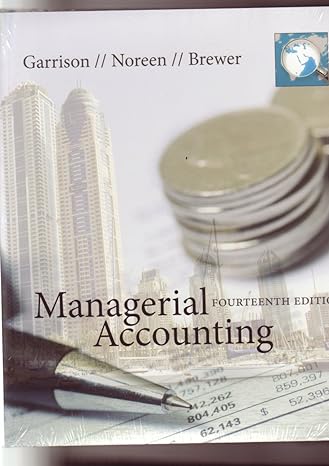Variance Analysis in a Hospital [LO1, LO2, LO3] Whats going on in that lab? asked Derek Warren,
Question:
Variance Analysis in a Hospital [LO1, LO2, LO3]
“What’s going on in that lab?” asked Derek Warren, chief administrator for Cottonwood Hospital, as he studied the prior month’s reports. “Every month the lab teeters between a profit and a loss.
Are we going to have to increase our lab fees again?”
“We can’t,” replied Lois Ankers, the controller. “We’re getting lots of complaints about the last increase, particularly from the insurance companies and governmental health units. They’re now paying only about 80% of what we bill. I’m beginning to think the problem is on the cost side.”
To determine if lab costs are in line with other hospitals, Mr. Warren has asked you to evaluate the costs for the past month. Ms. Ankers has provided you with the following information:
a. Two basic types of tests are performed in the lab—smears and blood tests. During the past month, 2,700 smears and 900 blood tests were performed in the lab.
b. Small glass plates are used in both types of tests. During the past month, the hospital purchased 16,000 plates at a cost of $38,400. This cost is net of a 4% purchase discount. A total of 2,000 of these plates were unused at the end of the month; no plates were on hand at the beginning of the month.
c. During the past month, 1,800 hours of labor time were used in performing smears and blood tests. The cost of this labor time was $18,450.
d. The lab’s variable overhead cost last month totaled $11,700.
Cottonwood Hospital has never used standard costs. By searching industry literature, however, you have determined the following nationwide averages for hospital labs:
Plates: Three plates are required per lab test. These plates cost $2.50 each and are disposed of after the test is completed.
Labor: Each smear should require 0.3 hours to complete, and each blood test should require 0.6 hours to complete. The average cost of this lab time is $12 per hour.
Overhead: Overhead cost is based on direct labor-hours. The average rate of variable overhead is
$6 pe r hour .
Required:
1. Compute the materials price variance for the plates purchased last month, and compute a materials quantity variance for the plates used last month.
2. For labor cost in the lab:
a. Compute a labor rate variance and a labor efficiency variance.
b. In most hospitals, three-fourths of the workers in the lab are certified technicians and one-fourth are assistants. In an effort to reduce costs, Cottonwood Hospital employs only one-half certified technicians and one-half assistants. Would you recommend that this policy be c ontinued? E xplain.
3. Compute the variable overhead rate and efficiency variances. Is there any relation between the variable overhead efficiency variance and the labor efficiency variance? Explain.
PROBLEM 10-11 Basic Variance Analysis [LO1, LO2, LO3]
Barberry, Inc., manufactures a product called Fruta. The company uses a standard cost system and has established the following standards for one unit of Fruta:
During June, the company recorded this activity related to production of Fruta:
a. The company produced 3,000 units during June.
b. A total of 8,000 pounds of material were purchased at a cost of $46,000.
c. There was no beginning inventory of materials; however, at the end of the month, 2,000 pounds of material remained in ending inventory.
d. The company employs 10 persons to work on the production of Fruta. During June, they worked an average of 160 hours at an average rate of $12.50 per hour.
e. Variable manufacturing overhead is assigned to Fruta on the basis of direct labor-hours. Variable manufacturing overhead costs during June totaled $3,600.
The company’s management is anxious to determine the efficiency of Fruta production activities.
Required:
1. For di rect m aterials:
a. Compute the price and quantity variances.
b. The materials were purchased from a new supplier who is anxious to enter into a longterm purchase contract. Would you recommend that the company sign the contract?
Explain.
2. For labor employed in the production of Fruta:
a. Compute the rate and efficiency variances.
b. In the past, the 10 persons employed in the production of Fruta consisted of 4 senior workers and 6 assistants. During June, the company experimented with 5 senior workers and 5 assistants. Would you recommend that the new labor mix be continued? Explain.
3. Compute the variable overhead rate and efficiency variances. What relation can you see between this efficiency variance and the labor efficiency variance?
Step by Step Answer:







